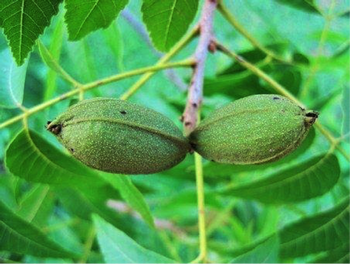Pecan
-
Scientific NameCarya illoensis
-
General InformationLarge deciduous tree. Challenging to grow in Northern California as they need long, hot, humid summers. Technically not a nut, but a drupe -- a fruit with a single stone or pit, surrounded by a husk. Outer husk starts out green, turns brown at maturity, then splits to release thin-shelled nut.
 Photo: Pixabay
Photo: Pixabay -
When to Plant
Best planted bare root in winter, November through February. Does not grow true from seed.
-
Planting
They are grown on seedling root stocks and take between 5 to 10 years to bear fruit. Do best in long, hot summers with lots of sun. Grows 70 to 100 feet tall and 40 to 75 feet wide, with a trunk up to six feet in diameter. Can bear fruit for hundreds of years. Plant far enough apart to prevent crowding. In California, traditional pecan orchards contain approximately 50 trees per acre.
-
Soil Requirements
Does best in deep, well-drained soil, but does okay in soil with a heavier clay content. Prefers pH between 6 and 7.
-
Water Requirements
40 inches per year for a full tree.
-
Fertilizing
Nitrogen and zinc are the two nutrients most often required by pecan trees annually. Phosphorus and potassium are rarely needed in pecans. Learn more.
-
Pollination
Male and female flowers are on the same tree, but they mature at different times. Only the female flowers produce fruit. They are wind pollinated, so at least two different varieties should be planted close to each other. Choose for pollen shed and receptivity (Type 1 and Type 2). Bees and other insects will also help cross-pollinate the trees. Pecan trees can "alternate bear," meaning they can bear heavily one year and light the next. Fruit spikes on tips of new shoots. Nut growth begins after pollination and extends through shell hardening (May to August), approximately 90 days after pollination. Between August and October, the kernel develops and fills out, which takes about 90 days.
-
Harvesting
Most varieties require at least 180 days for nuts to mature. Pecans mature from late August through November, depending on variety.
Harvest as soon as the green hulls begin to split and the shells inside are brown. Knock them from the tree using a non-metal pole with a hook at the end to shake the branches. (Commercial growers use a hydraulic shaker that clamps onto the tree trunk with padded arms, and shakes the tree to dislodge nuts.)Remove the hulls asap. If they do not separate easily from the shells, they are not yet mature. Wash hulled nuts, spread out in well-ventilated area (shady) to dry for a few days, stirring them daily. Protect from birds. They are fully cured when the kernel of the cracked nut breaks cleanly rather than bending. A mature tree can yield 40 to 50 pounds of nuts per year.
The U.S. produces 80 to 95 percent of the world's pecans, mostly from Georgia. About two percent come from California.
-
Storage
Store pecans in the shell in a cool, dry, well-ventilated location for several months or a year refrigerated. Once shelled, store in the refrigerator for up to three to six months, in covered glass jars or plastic bags to prevent the absorption of odors. Pecan pieces have a shorter shelf-life than pecan halves. This time reduction is in proportion to the surface exposure of the pieces. If pecans need to be stored for more than a year, either in the shell, cracked, or shelled, they must be placed in the freezer. You can store in-shell pecans for one year at 32°F to 45°F and for two years at 0°F. Shelled pecans will store for one year at 32°F and for two years or more at 0°F.
-
Good Varieties for Marin
Pecans are not a good choice for Marin. Many varieties planted in the Southern San Joaquin Valley are named after Native American Indian tribes.
The most common cultivars in California: 'Wichita' 'Cheyenne' 'Pawnee' 'Western Schley' 'Shoshone' -
Helpful Tips
Wear gloves to avoid staining hands while harvesting. The trees are very messy. If planting dormant nursery trees, prune off the top one-third to one-half of the previous season’s growth. This will leave a whip about three feet tall. Pruning with this “heading cut” encourages vigorous, upright shoot growth the following spring from the two or three nodes immediately below the cut-back point, allowing you to select a strong central leader a year later. When training a young pecan tree, the goal is to have six to 10 widely angled side branches spaced eight to 14 inches apart and arranged in a spiral around the central leader. Pecans require minimal pruning to develop nuts, but orchard trees are pruned smaller to optimize light and production. Hand harvesting the nuts from the upper portions of a tall, mature pecan tree is difficult. To make harvesting easier, prune every year to keep the tree small.
-
Common Problems
Don’t leave nuts on the ground, as they will attract insects, mold, and birds.
-
Pests- Diseases & More
In California, aphids are the most common pest. The yellow pecan aphid and black margined aphid pierce the leaf veins to extract photosynthates and water from the leaves, which can distort and stunt the growth of shoots and roots.

